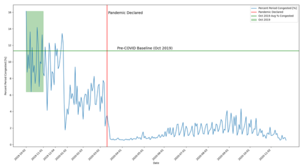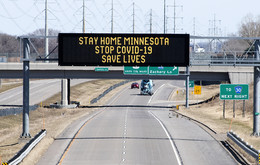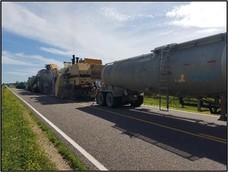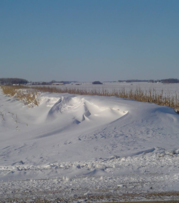|
Transportation Research Update


As the COVID-19 pandemic kept people at home, decreases in travel were to be expected. Traffic congestion was effectively eliminated. Traffic levels slowly increased as the state reopened in the late summer and early fall of 2020. To ease congestion, MnDOT and its partners strive to develop effective travel demand strategies and need solid estimates of how successful a given program might be in reducing traffic. Using the real-life experiment in drastic traffic volume changes, researchers identified the relationship between incremental changes in traffic volume and congestion, which will inform agency efforts to ease congestion.
The research team analyzed traffic volume before and during the pandemic to understand congestion on area freeways—both from a regional perspective and in specific corridors. They found the tipping point, where even small increases in traffic volumes will create congestion that becomes volatile—or unpredictable—expanding across the region. They also identified some unequal community impacts of traffic congestion across the region and initial indications of how other, nonfreeway roads respond to regional congestion. The forced travel reductions of 2020 may ultimately help in making traffic more manageable for everyone.
|

Remote work during the pandemic resulted in a 30% traffic reduction, including eliminating usually congested areas. As teleworking continues at some level, it will continue to change traffic patterns and have implications for highway planning and congestion mitigation. To understand the possibilities for future telecommuting, a research project explored employer and employee perceptions of remote work during COVID and post-pandemic.
Researchers analyzed survey data and found unexpected variations in populations choosing or able to work remotely. Specifically, younger workers and those with children are less likely to take advantage of telecommuting. White employees with higher incomes and education levels are more likely to telework. Perceptions between employees and employers varied also. Employees, for example, felt they were more productive while working remotely, while employers thought productivity was unchanged or declined. Less than 60% of employers were found to have telework policies but most were open to some level of remote work. These results will inform MnDOT’s future highway planning as well as the state government’s own telework policies.
|

Motorists suddenly stopping or swerving to avoid small animals crossing the road create significant hazards. Pedestrians trying to assist the animals across the road risk serious injury, as do motorcyclists and bicyclists if they hit an animal. Turtles are the world’s most imperiled group of vertebrates, and roads are a primary threat. A multiyear research project has found an effective solution for these public safety and conservation concerns.
Researchers conducted an in-depth study observing the impact of a chain-link fence design in keeping turtles off the roads. After retrofitting the design with 0.5-inch wire mesh, they found turtle mortality decreased up to 91%. The fence design uses readily available and cost-effective materials. Combined with under-the-road culverts for habitat connectivity, MnDOT will now have standard designs to use in projects. In addition to the cost savings from avoiding extra engineering or design work, public safety and conservation are enhanced.
|

A cost-effective and environmentally friendly asphalt repaving method will now be more efficient. Cold in-place recycling (CIR) involves pulverizing the top layer of old pavement, mixing it with water and a stabilizing agent such as emulsified asphalt, and reapplying the mixture to fill in holes and cracks. A final layer is added to seal and preserve the recycled pavement layer. This process minimizes the need for using new material and transporting materials to and from the construction site.
The recycled asphalt layer, however, must sufficiently harden before the top layer can be placed and the road reopened to traffic. Local road engineers needed to know how long it will take for curing to occur. New research identifies the factors that impact CIR pavement curing, including the types of materials used, the outside temperature and the compacted density of the recycled asphalt. Researchers developed a Curing Prediction Model spreadsheet and guidance to reliably estimate the process time. This new knowledge will help to optimize construction schedules and minimize traffic disruptions.
|

MnDOT can decrease the nearly $100 million spent on snow and ice control each year by implementing snow fences. Cost savings, improved winter road safety and environmental benefits can be provided by private landowners who build or grow snow fences on their property. Previous work has shown the benefits of snow fences far outweigh the costs. MnDOT provides financial incentives for property owners, and the agency would like to encourage increased participation in the program.
A new project provides greater insight into landowner motivations and concerns with using fences. Investigators prepared 30 case studies based on interviews with early adopters and used what they learned to expand the publicly available Farmmaps tool, which is already used to share conservation practices. They also improved a snow fence inventory tool used by the agency and refined training materials to assist MnDOT district staff in engaging with landowners.
|
-
Community Power Minnesota: Transportation and Happiness (08/01/22, The Redford Center)
-
Building a Better Road: How MnRoad Facility on I-94 is Creating the Road of the Future (07/29/22, Kare11)
-
Minnesota's Telecommuting Patterns (07/15/22, TPT)
-
Clear Roads Selects 2022 Research Projects (07/08/22, Clear Roads)
-
Reclamation and Recycling Show Benefits after Three Minnesota Winters (05/26/22, Pavement Preservation Journal)
-
MnDOT Studying ways to Bring Congestion Relief for Drivers (04/26/22, Star Tribune)
|
|
MnDOT invites and encourages participation by all. If you need an ASL, a foreign language interpreter, or other reasonable accommodation, or need documents in an alternative format (such as braille or large print), please email your request to Janet Miller at ADArequest.dot@state.mn.us or call 651-366-4720. |
|
|
|